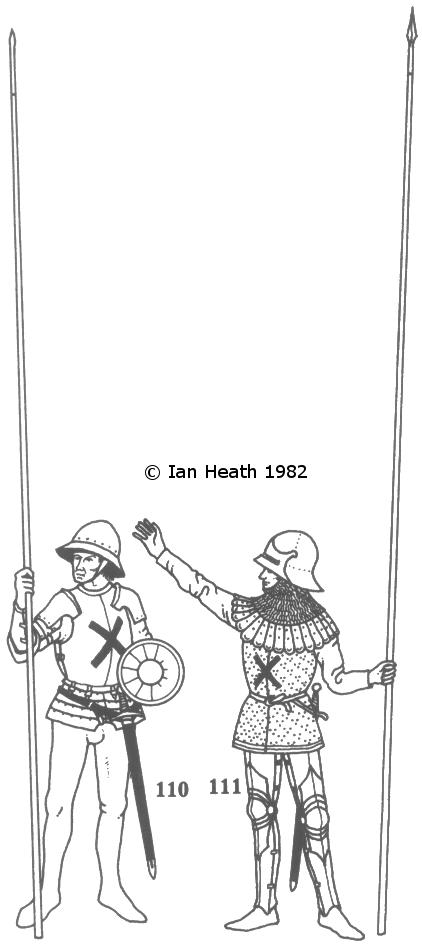
Register a SNAP EBT card with Amazon

Register a SNAP EBT card with Amazon
BURGUNDIAN PIKEMEN
An extract from Armies of the Middle Ages, volume 1
by Ian Heath


110 & 111. BURGUNDIAN PIKEMEN
Figure 110 is based on Schilling's pictures of the Battle of Morat. His armour comprises a plate corselet with a short fauld but, in accordance with Burgundian regulations of 1472, only his right arm is armoured, his left being protected by a small targe which, however, does not occur in contemporary pictures so was presumably unpopular (though a ms. of c. 1485 depicting Burgundian troops of this period shows pikemen carrying larger oval shields 30-36" deep, with the crossed ragged staffs, flint-and-stele and flame devices described under 115). Schilling's pictures of Grandson depict similarly equipped billmen (though with both arms unprotected except for gauntlets) and some similarly armoured archers.
The St Andrew's cross, worn by both these figures, had been adopted as the Burgundian field-sign by c. 1416 at the latest. It was strictly 2 ragged staffs crossed in saltire but also sometimes appeared as crossed arrows on flags; on clothes it was more probably a plain cross, as here. Officially it was supposed to be worn by all Burgundian troops, though a reasonable number of contemporary pictures show Burgundian troops without. Most often it was red, less often yellow, while one later 15th century source depicts a Burgundian at the siege of Orleans in 1428-29 wearing a dark blue cross. In addition to the cross, after 1471 mi-parti uniforms of blue and white were also worn both by the infantry and the mounted troops of the ordinance companies. Late-15th century illustrations indicate that this closely resembled the sleeveless tunics of figures figures 18 and 19 in style (though at least one long-sleeved example is to be found), with the blue usually but not always worn on the right, and the red cross embroidered on the front but sometimes apparently not on the back. The same ordinance that specified these uniforms also instructed Burgundian men-at-arms to wear blue and white plumes on their helmets (as did the horses, on their heads) and vermilion velvet crosses on their armour.
Figure 111 is a Lowland pikeman in Burgundian service, from a ms. of 1460 which shows others in even heavier armour including plackart, arm-harness and an armet in place of the sallet. Jean de Wavrin describes Flemish pikemen in the Burgundian army before Amiens in 1471 as equipped with sallet, jack, sword and slender pike with a long blade that was triangular in section; he says they 'knew how to handle pikes better than anyone'. Lowland pikemen raised in 1476 wore the blue and white ducal uniform mentioned above.